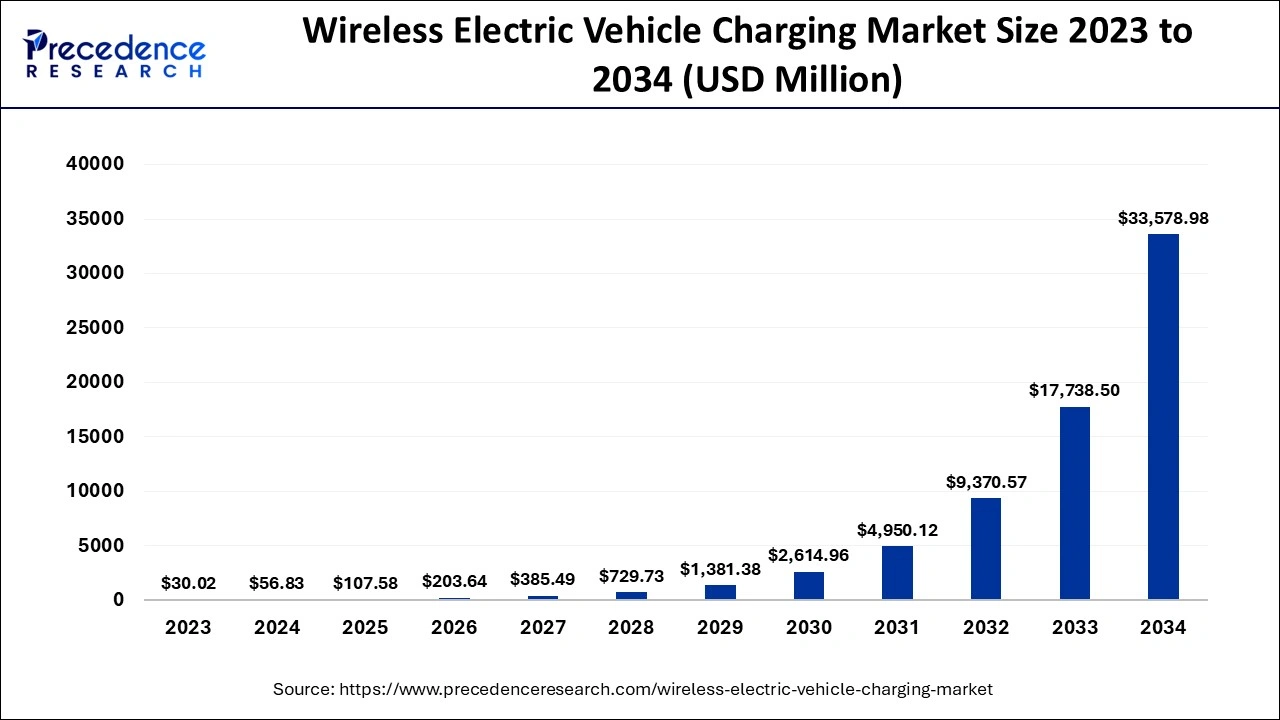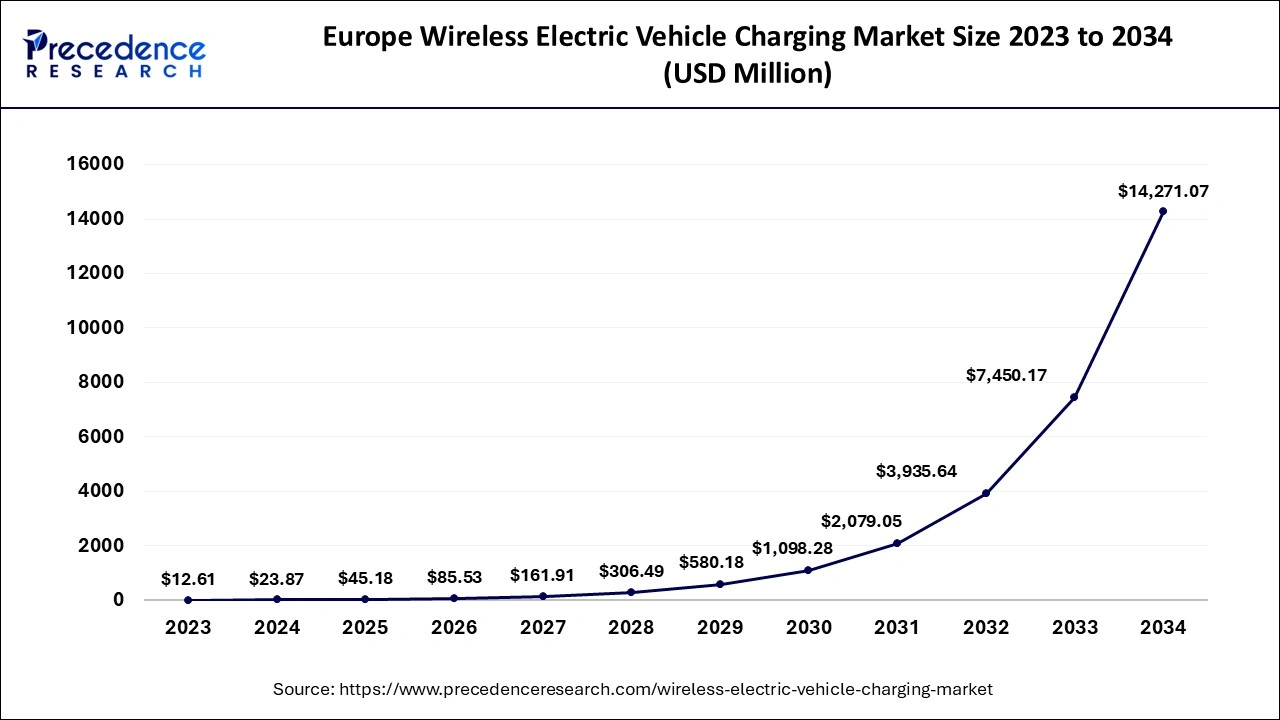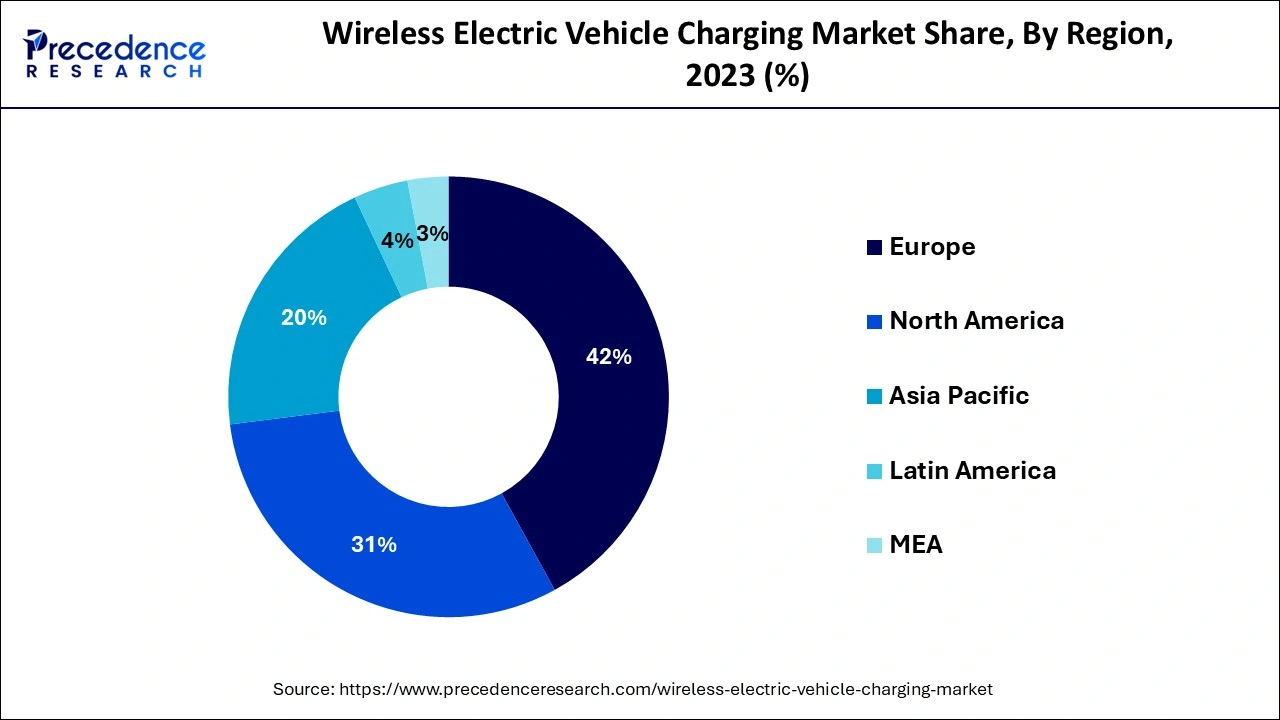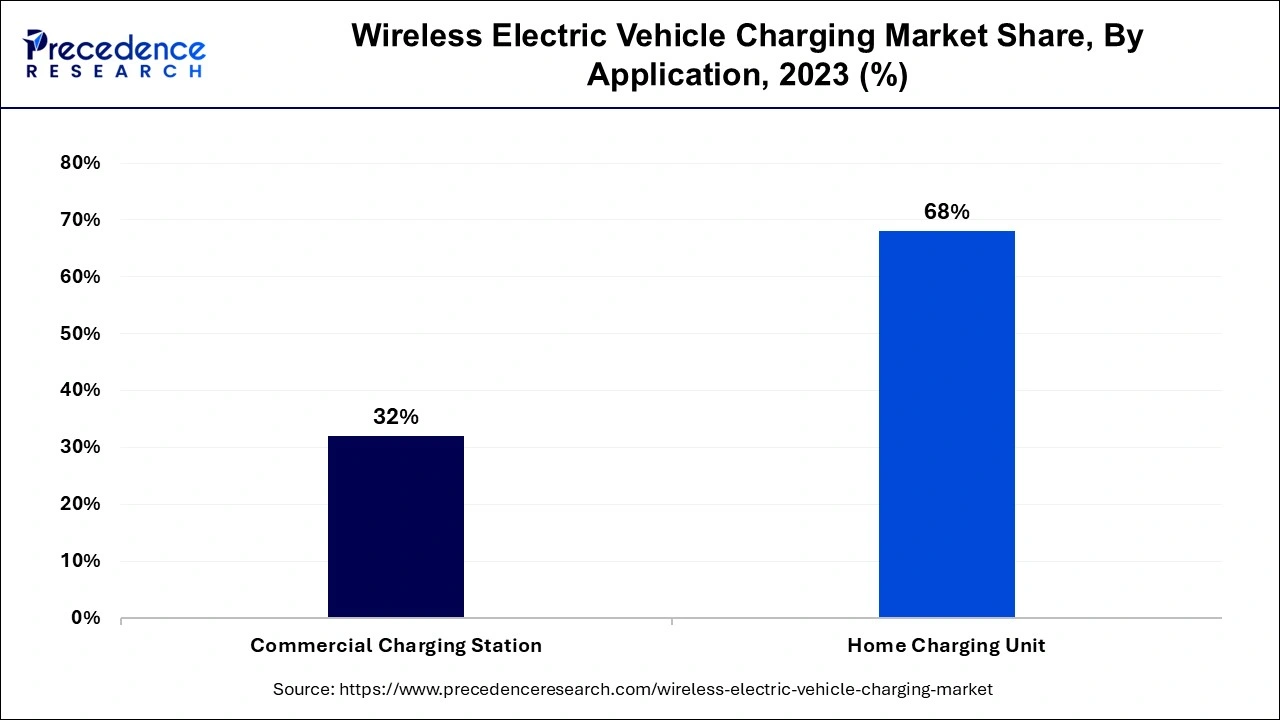April 2025
The global wireless electric vehicle charging market size accounted for USD 56.83 million in 2024, grew to USD 107.58 million in 2025 and is predicted to surpass around USD 33578.98 million by 2034, representing a healthy CAGR of 89.30% between 2024 and 2034.
The global wireless electric vehicle charging market size is accounted for USD 56.83 million in 2024 and is anticipated to reach around USD 33578.98 million by 2034, growing at a CAGR of 89.30% from 2024 to 2034.

The Europe wireless electric vehicle charging market size is evaluated at USD 23.87 million in 2024 and is predicted to be worth around USD 14271.07 million by 2034, rising at a CAGR of 89.50% from 2024 to 2034.

Segmentation of wireless electric vehicle charging based on the basis of geography Asia Pacific region to be highest region to contribute to enhance the increased market revenue share with increasing demands from the market and consumers due to developed technologies. Other regions contributing for the increasing the market growth such as North America, Europe, Latin America, Middle East and Africa are also in process to increase the market to grow to a larger extent.

Wireless electric vehicle charging involves charging of the vehicle without any cable and transmission of the energy is done through electromagnetic induction transmission of electrical energy to the vehicles. The vehicle to be parked and placing of the vehicles near the charging stations or the inductive pad and transferring of the electric power and second induction coil is placed in the vehicles which receives the power. It is the safe method of technology for transferring of the electric power, reliable and convenient. By eliminating the usage of cables and connectors and increasing the efficiency of the vehicles and cost effective and most reliable convenient method has increased the market trend. Impact of the covid-19 on the wireless electric vehicle charging has declined the market growth due to rules and regulations imposed by the government and shutdown of the nation with the ceased transportation which hampered the supply of goods from one end to another. Moreover, spread of corona virus affected the automotive market and the electric vehicles due to underdeveloped infrastructures has challenged the market to grow.
Moreover, wireless charging electric vehicle is about transmission of the energy without wire or cable magnetic induction is used for transmitting energy which is efficient, convenient, reliable, cost effective. Increased adaption of the wireless charging electric vehicles with benefits of emission free society with, higher efficiency, low maintenance, increased rates of the fuels and oils, developing infrastructure and increased research and development by the automotive industry have boost the market for increased revenue share of wireless charging electric vehicle market.
Support from the government with increased investing funds for developing more wireless charging electric vehicles and developing infrastructure of charging stations. The key market players involved in introducing, developing, manufacturing and producing with developed technologies have helped to boost the wireless electric vehicle charging market.
The pandemic effect on the wireless charging vehicle on the market led to low down the height of the market share due to less demands and manufacturing of the new integrated systems in the wireless charging vehicle technology increased investment from the market players with increased innovations hampered the manufacturing of the vehicles. Later with improved pandemic condition in the market led to higher demands from the consumers for the electric vehicle wireless charging with benefits such as low emission of the carbon dioxide gas with increased rates of the fuel overall regions have gained the consumers attention towards the wireless charging of the vehicle.
| Report Coverage | Details |
| Market Size in 2024 | USD 56.83 million |
| Market Size by 2034 | USD 33578.98 million |
| Growth Rate from 2024 to 2034 | CAGR of 89.30% |
| Base Year | 2023 |
| Forecast Period | 2024 to 2034 |
| Segments Covered | Power Supply, Vehicle, Application, Components, Charging Type, Distribution Channel, Propulsion Type, Charging System and Geography |
Increasing number of populations with increasing number of demands from the market with improved developed technology have rise the market high. Rapid acceptance of the developed innovative technologies with increased benefits from the wireless electric vehicle charging such as ease of use, zero emission of carbon dioxide and increased global environment, higher efficiency, low maintenance and no wires and cables involved for charging decreased shock effects. The battery of the vehicle is charged through transmission of power from one magnetic coil to another coil. In wireless charging of electric vehicle size of the battery is smaller and light in weight as that of used in convenient vehicles. These two are major reasons for reducing the cost of the electric vehicles.
Faster charging of the wireless charging electric vehicle, they can charge the car wherever they have parked the vehicle. Increased awareness among the people with rising demands have extended the market to grow at a larger extent. Market players are major role players in new innovations across the regions and continuous research and development have contributed to increase the wireless electric vehicle charging with high demands and acceptance from the market.
Segmentation of wireless electric vehicle charging based on the power supply it is divided in to 3 - <11 KW, 11 - 50 KW, >50 KW. The power supply of 3 -11 KW is the fastest expanding in electric supply of power it is used in small batteries and medium size batteries. It is the widest growing segment in household charging and at working place.
Segmentation of wireless electric vehicle charging based on the basis of propulsion it involves BEV and PHEV. BEV is the highest growing sector to increase the market to a greater extent during the forecast period. In BEVs wireless charging is increased than in PHEVs. Source of energy and electric power is battery. BEV segment to enhance the market more than PHEV during the forecast period.
Segmentation of wireless electric vehicle charging based on the basis of vehicle includes such as commercial vehicles and passenger cars. Passenger car to hold the highest position in the increased market revenue share an commercial vehicles to increase the market during the forecast period.
Segmentation of wireless electric vehicle charging includes various segments involves based on distribution channel includes aftermarket, OE market. Based on component includes base charging pad, power control unit, vehicle charging pad. Based on charging type such as Dynamic wireless charging system, stationary wireless charging system. Based on charging system includes magnetic power transfer, capacitive power transfer, inductive power transfer.
Segmentation of wireless electric vehicle charging based on the basis of application involves such as home charging unit and commercial charging station. Commercial charging station cover the rate at a CAGR of 45% with increased developments and technologies with developed infrastructures in various places with increased demand.

Home charging station involves medium and smaller size batteries with light weight with higher CAGR with enhanced utilization and increased market during the forecast period.
By Power Supply
By Vehicle
By Application
By Components
By Charging Type
By Distribution Channel
By Propulsion Type
By Charging System
By Geography
For inquiries regarding discounts, bulk purchases, or customization requests, please contact us at sales@precedenceresearch.com
No cookie-cutter, only authentic analysis – take the 1st step to become a Precedence Research client
April 2025
January 2025
January 2025
September 2024